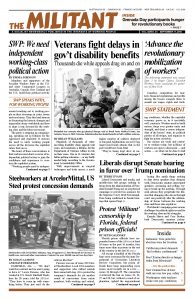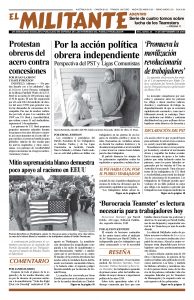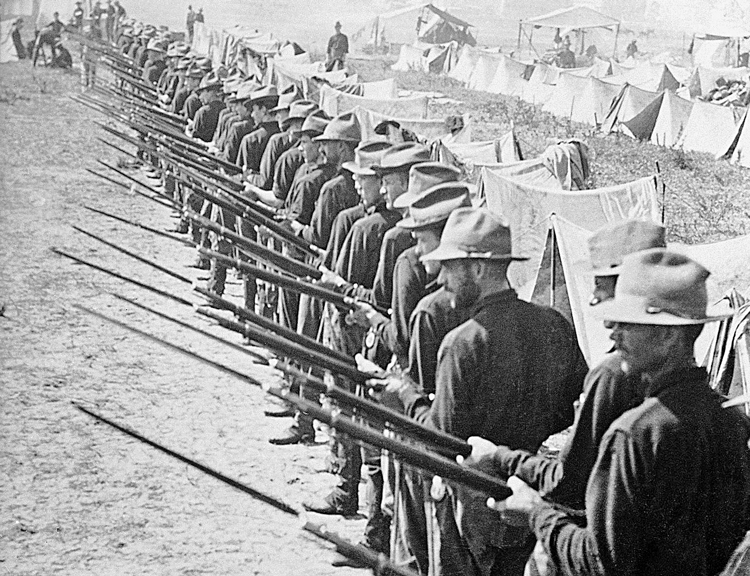The excerpt below is taken from a 1935 essay by George Novack that appears in America’s Revolutionary Heritage, one of Pathfinder’s Books of the Month for September. Novack explains why U.S. financial capital came late to rule the roost in the development of capitalism here and describes how U.S. imperialism emerged at the end of the 19th century. Copyright © 1976 by Pathfinder Press. Reprinted by permission.
In reality, the special peculiarities of American capitalism were a product of the given constellation of economic forces constituting the world market, in which the economic forces of the United States were throughout this period a subordinate factor. American capitalism has always been an organic part of world capitalism. The peculiarities of its economic development were not spontaneously generated from within itself alone, but were the outcome of the interactions between the national and the international productive forces and relations. This we hope to make clear when we consider the peculiarities of American imperialism. …
The United States entered upon its imperialist career later than the European powers because industrial capitalism held the center of the stage much longer here than in England, France, or Germany. Although the concentration of industry began relatively earlier and proceeded at a more rapid rate in the United States than in Europe, and trustification was more highly developed, finance capital did not begin to shoulder aside industrial capital in the sphere of monopolized industry until the close of the century, and did not completely control the strategic centers of national economy and the state until the World War. Since imperialist policies are an outgrowth of the domination of finance capital, the key to the relatively slow development of American imperialism is to be found in the late blooming of finance capital. …
Industry, then, was trustified after the Civil War under the supervision of industrial, rather than financial, capital. The giant monopolies of the period, Standard Oil, Carnegie Steel, Armour & Company, the American Sugar Refining Company, were organized and controlled by industrial capitalists like Rockefeller, Carnegie, Armour, and Havemeyer, and the new capital poured into them came from reinvested profits or from foreign capital directly invested in the industry, rather than from the flotation of bond and stock issues by banks and investment houses. The outstanding exception to this rule was the railroads, because of their greater capital requirements.
Finance capital began to supersede industrial capital and take the initiative in forming monopolies about the beginning of the century. The organization of the Steel Trust in 1900 by the House of Morgan was the first large-scale operation in this field by finance capital. When Carnegie sold his steel companies to the banking syndicate headed by Morgan and retired to his philanthropies, he symbolized the retreat of the industrial capitalist before the invasion of the financier. It is equally significant that Carnegie was, politically, an outspoken anti-imperialist and one of the chief financial backers of the Anti-Imperialist League, which organized the opposition to the Republican Party’s imperialist policies— until the Morgan partners forced him to withdraw by pointing out that such propaganda was jeopardizing McKinley’s reelection and the tariff essential to the Steel Trust.
While Morgan and Company were preparing to launch the Steel Trust in 1899, they floated the first important foreign loan issued in this country, the bonds of the Mexican Republic. This was followed two years later by a fifty-million-dollar loan to Great Britain to help pay the costs of the Boer War, the father of the Morgan war loans to England that helped suck the United States into the World War.
But although financial capital began to get a foothold before the 1914–18 war, it did not become the absolute governor of American economic and political life until the war. The transformation of American capitalism from the commercial-industrial (colonial) stage to the industrial-financial (imperialist) stage was accomplished in two separate steps. The period from the Civil War to the turn of the century completed the transfer of the American economy from a predominantly agricultural to an industrial basis. The period preceding the World War marked the beginning of its transformation from an industrial capitalist into a financial capitalist, imperialist nation.
Economically speaking, the United States did not shed all its colonial characteristics until the World War. It was a debtor nation and imported tremendous quantities of capital from Europe. Throughout the nineteenth century, foreign capital poured in an unending stream into the United States and was one of the most potent factors in its rapid economic development. Canals and railroads, extractive and manufacturing industries, southern plantations and western ranches as big as baronial domains sprang into being at the touch of the magic wand of foreign capital, and English capital in particular. The New York money market was but a satellite of the London and continental money markets.
Before the World War the United States was an industrial rather than a financial competitor of the European powers. This can be seen in the comparatively small part played by American capital in the transformation of Japan from a tiny feudal island empire into a world power, although the guns of the United States Navy first battered down the gates of Japan and opened them to foreign trade. The United States remained in the ranks of the second-rate powers until it appeared on the scene of military operations in Europe to save the Allies— and its own investments. …
The decisive qualitative change in the character of American capitalism occurred during the war, which reversed the political and financial relationships between America and Europe and transformed the United States from a provincial parvenu in the society of the Great Powers into the colossus of the capitalist world.


